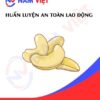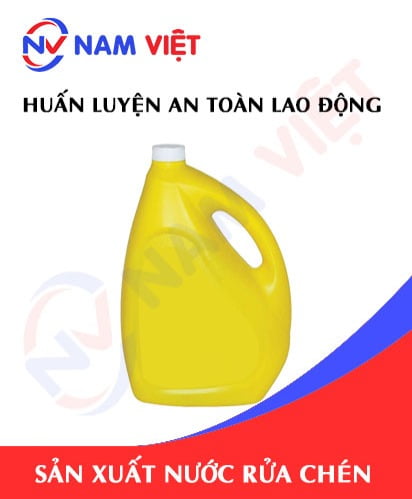Occupational Safety Training for Beer Manufacturing
99,000 ₫
Note: The above price is calculated for one person, the price may fluctuate depending on the number of trainees participating in the course and the market movement. For more accurate price support, please refer to the price list or contact our consulting staff directly.
Occupational safety is an important issue in factory manufacturing beer and needs to be addressed promptly to ensure the health and safety of workers, enhancing the reputation of businesses. The Occupational Safety Training course is one of the effective solutions to raise awareness of how to prevent occupational accidents for workers participating in beer manufacturing.
Table of Contents
Toggle1. Overview of Beer
a. What is Beer?
- Beer is a type of beverage made from barley or wheat, water, and yeast. Beer usually has a bitter taste and various aromas depending on the types of hops used in the manufacturing process. Beer has low to high alcohol content and is widely consumed around the world.
- Currently, the beer industry in Vietnam is developing very strongly. In the past, imported brands dominated the market, but in recent years, local beer brands have emerged and gained significant market share. According to statistics, Vietnam currently has more than 50 beer brands, and local beer products account for about 95% of the domestic market share.

b. Beer Manufacturing Machinery
Beer manufacturing machinery includes:
- Malt grinder: The malt grinder is used to grind malted barley or wheat into malt powder. This malt powder is used in the beer manufacturing process to create fermentable sugars.
- Mash tun: The mash tun is used to mash the ingredients after they have been combined. During this process, yeast is added to convert sugars into alcohol and CO2.
- Filter tank: After mashing, the beer is transferred to the filter tank to remove solid residues.
- Mixing tank: The mixing tank is used to blend all beer components together after filtering.
- Bottling and canning machine: These machines are used to fill beer into bottles and cans with precise accuracy.
- Bottle washer: The bottle washer cleans beer bottles before filling.
- Beer quality measurement equipment: These devices measure protein content, alcohol content, pH, sugar content, and other quality indicators to ensure product quality.

c. Typical Beer Manufacturers
In Vietnam, there are many notable beer manufacturers, including:
- Sabeco: Sabeco is the leading company in beer manufacturing in Vietnam, producing famous brands such as Saigon Beer, 333 Beer, Saigon Gold, Saigon Special, and Saigon Export.
- Habeco: Habeco is the second largest beer manufacturer in Vietnam, producing famous brands such as Hanoi Beer, Truc Bach Beer, and Hanoi Premium.
- Carlsberg Vietnam: Carlsberg Vietnam is a joint venture between Carlsberg Group and Habeco, producing brands such as Carlsberg, Tuborg, and Halida.
- Heineken Vietnam Brewery: Produces brands such as Heineken Beer, Tiger Beer, and Larue Beer.
- Song Lam Brewery: Produces Saigon Red Beer, Saigon Green Beer, Saigon Special Beer, Truc Bach Beer, Huda Beer, Huda Gold Beer, Huda Green Beer.
- Habeco Bac Ninh: Produces Hanoi Beer, Truc Bach Beer, Hanoi Premium Beer.
- Hanoi Center for Research and Manufacturing of Beer – Wine – Beverages (CETEBAL): Produces Hanoi Beer and Saigon Beer.

d. Specific Jobs in a Beer Manufacturing Factory
Group 1
- CEO, deputy CEO, department heads in the beer manufacturing factory.
Group 2
- Safety officer: managing safety in the factory, designing safety procedures, supervising and ensuring employees comply with safe working procedures.
Group 3
- Raw material preparation: Beer is made from ingredients such as barley, hops, water, yeast, and other additives. During raw material preparation, these components are processed for the next manufacturing stage.
- Brewing: This is a key step where ingredients are mixed with water and boiled. When the mixture reaches the required temperature, yeast is added to start fermentation.
- Fermentation and secondary fermentation: Yeast consumes the sugars in the mixture and converts them into alcohol and carbon dioxide, creating the distinctive taste and aroma of beer. In some cases, secondary fermentation is conducted to achieve the best flavor and color.
- Filtration and refinement: After fermentation, beer is filtered to remove residues and impurities. Then, it is refined to reduce cloudiness and improve taste.
- Bottling and canning: Beer is filled into bottles or cans for distribution. This usually includes cleaning and sterilizing bottles or cans before filling and sealing.
- Packing and transportation: After bottling or canning, beer is packed and prepared for distribution to retail stores or distribution points.
Group 4
- Office, service, sales, marketing jobs.
- Production management, quality control, human resource management, materials management, financial and accounting management.
- Research and development of new products, packaging and product design.
2. Overview of Occupational Safety Training in Beer Manufacturing
This article focuses on Group 3, because Group 3 directly participates in the production process and faces the highest occupational safety risks. For other groups, see here.
a. What is Group 3 Occupational Safety Training?
- Group 3 occupational safety training consists of sessions that equip workers with awareness on preventing occupational accidents.
- The course helps workers identify hazards and avoid risks to minimize workplace accidents.
REGISTER FOR OCCUPATIONAL SAFETY TRAINING SERVICE
b. Training Duration
Initial safety training
- Total training time is at least 24 hours, including assessment.
- 8 hours of theory on labor safety laws and policies
- 8 hours of theory on basic labor safety and hygiene knowledge
- 4 hours of theory on specialized training content
- 2 hours of practice on specialized training content
- 2 hours of final theoretical assessment
The safety training center divides training into multiple sessions depending on worker schedules, usually 6 sessions over 3 days if the company arranges continuous learning time.
Periodic safety training
- Before the occupational safety card expires, workers wishing to renew it must take periodic occupational safety training, with a duration of at least 50% of the initial training time.
Explanation: total periodic training duration is at least 12 hours, including assessment. After completing the course and passing the test, the worker’s safety card will be renewed or reissued.
c. Training Content
| No. | TRAINING CONTENT | TRAINING DURATION (HOURS) | |||
| Total | Including | ||||
| Theory | Practice | Assessment | |||
| I | Labor safety laws and policies | 8 | 8 | 0 | 0 |
| 1 | Overview of the legal document system on labor safety and hygiene. | 6 | 6 | ||
| 2 | Standards and technical regulations on labor safety and hygiene. | 1 | 1 | ||
| 3 | Specific regulations by government agencies on safety and hygiene when constructing, expanding, or renovating facilities, and in manufacturing, storing, and inspecting machines, equipment, materials, or substances with strict safety requirements. | 1 | 1 | ||
| II | Basic knowledge on labor safety and hygiene | 8 | 8 | 0 | 0 |
| 1 | Basic knowledge of hazards and harmful factors at the workplace. | 4 | 4 | ||
| 2 | Methods to improve working conditions. | 1 | 1 | ||
| 3 | Safety culture in production and business. | 1 | 1 | ||
| 4 | Rights and obligations of employers and employees; safety policies; functions and duties of safety officers. | 1 | 1 | ||
| 5 | Safety rules, signs, instructions, use of safety devices, personal protective equipment; first-aid and occupational disease prevention skills. | 1 | 1 | ||
| III | Specialized training content | 6 | 4 | 2 | 0 |
| Comprehensive knowledge of machines, equipment, hazardous substances; risk analysis, evaluation, and management; safe work procedures with machines, equipment, and substances requiring strict safety compliance. | 6 | 4 | 2 | ||
| IV | Final assessment | 2 | 2 | 0 | 0 |
| Total | 24 | 22 | 2 | ||
See more training content of 6 groups
d. Occupational Safety Card
After completing the occupational safety training and passing the test, workers will be issued a Group 3 Occupational Safety Card (commonly called Group 3 Occupational Safety Certificate).
The card shows full information: full name, date of birth, specific job and working environment, training duration, red stamp, and signature confirming completion.
According to Clause 2 of Article 24 Decree 44/2016/ND-CP, there are two cases:
- If the employer and employee have a labor contract, the employer must sign, stamp, and seal the card for the Group 3 employee after completing the training and passing the test.
- If the worker is freelance or seasonal without a labor contract, the training unit must sign, stamp, and seal the card after training and passing the test.

3. Identifying Hazards in Beer Manufacturing
Hazards in beer manufacturing may include:
- During beer production, chemicals such as solvents, acids, thickeners, cleaning agents, etc., can pose dangers to workers if not used correctly or without proper protective equipment.
- The beer production process involves temperature-related steps, such as boiling, fermentation, etc. Unsafe working conditions or lack of protective gear may result in temperature-related accidents such as burns, heatstroke, etc.
- Machines and equipment in the beer factory can cause serious occupational accidents if used improperly or without following safety regulations.
- The beer production process involves microorganisms and different environments. Workers may be exposed to harmful microorganisms or unsanitary conditions, causing potential health impacts.
- The process also involves the use of gas, flammable chemicals, etc. The risk of explosions is high if safety regulations are not properly followed, which may lead to serious accidents.
- Beer factories produce large amounts of waste, including organic and chemical waste. Improperly handled waste can pollute the environment and harm human health.
- If electrical equipment in the factory is not regularly maintained or lacks proper insulation and waterproofing, it poses an electric shock risk to workers during production.
4. Common Occupational Accidents in Beer Manufacturing
Common occupational accidents in beer manufacturing include:
- Machine-related accidents: Machinery in beer factories can cause serious occupational accidents, such as collisions, cuts, crushing, explosions, and fires.
- Exposure to toxic substances: Chemicals used in beer production, such as additives, cleaning agents, water treatment chemicals, and toxic gases, may cause health issues for workers such as headaches, breathing difficulties, skin irritation, eye pain, or throat discomfort.
- Physical hazards: Accidents caused by physical factors, such as explosions, lightning, earthquakes, or incidents related to electricity, water, or gas.
- Injuries from heavy materials: Materials like beer barrels, packaging boxes, and equipment can cause serious injuries if not handled and operated correctly.
- Traffic accidents: Drivers transporting beer may also encounter road accidents during delivery.
5. Safety Measures When Participating in Beer Manufacturing
Safety measures when participating in beer manufacturing include:
- Ensure compliance with occupational safety regulations: Beer factories must follow occupational safety regulations, including regular equipment maintenance and inspection, training and guiding employees on safety, and wearing full personal protective equipment while working.
- Minimize accidents during beer transportation: Transporting beer is an important stage in production. Manufacturers should use safe and durable transport vehicles and properly package beer products to reduce the risk of damage during transportation.
- Ensure safety during production: Beer factories should use modern production equipment that meets safety and quality standards. Employees should be trained and instructed on occupational safety to ensure safe production processes.
- Ensure food safety and hygiene: Beer is a food product and requires food safety measures during production. Manufacturers must comply with food safety regulations and use safe equipment and chemicals to ensure product quality.
- Conduct periodic quality inspections: Manufacturers must perform regular quality inspections to ensure the safety and quality of beer products, including hygiene checks, product quality checks, and occupational safety inspections.
- Periodically conduct workplace environmental monitoring in factories to collect and analyze harmful factors affecting workers, adjusting measures to reduce hazards and prevent occupational diseases.

6. Benefits of Occupational Safety Training in Beer Manufacturing
An Toan Nam Viet provides enterprises with the following benefits after completing occupational safety training courses according to Decree 44/2016/ND-CP on occupational safety and hygiene:
- Workers can identify potential occupational hazards and take preventive measures to avoid accidents.
- Enterprises can establish risk prevention measures in production, operation, and maintenance processes.
- Reduce costs associated with occupational hazards.
- Uninterrupted production increases labor productivity and product quality.
- Ensure compliance with labor safety laws, reducing legal risks.
- Enhance credibility and professionalism, improving the enterprise’s brand.
An Toan Nam Viet’s courses are solutions to prevent external hazards that may cause injury or, in severe cases, death.
REGISTER FOR OCCUPATIONAL SAFETY TRAINING SERVICE
7. Customer Feedback After Completing Beer Manufacturing Safety Training
An Toan Nam Viet has years of experience partnering with enterprises across Vietnam, especially in southern provinces. This responsibility is invaluable, which is why Nam Viet’s Occupational Safety Training has been continuously professionalized. The motivation for our growth comes from positive feedback and suggestions from enterprises. Below are testimonials from our partners.
Hoa Dat Construction and Trading Joint Stock Company
“Nam Viet’s service has greatly simplified occupational safety and completing safety documentation for our work. The consultants were enthusiastic and responsive to our questions. Five stars for Nam Viet.”
See more customer interviews after using services from An Toan Nam Viet
8. Occupational Safety Training Capacity of An Toan Nam Viet
An Toan Nam Viet is a reputable occupational safety training center in Vietnam, continuously conducting training at factories, production plants, and construction sites nationwide (all 63 provinces of Vietnam).
REGISTER FOR OCCUPATIONAL SAFETY TRAINING SERVICE
Occupational Safety Training License
- An Toan Nam Viet has been inspected and certified by the Department of Occupational Safety under the Ministry of Labor, Invalids, and Social Affairs, confirming eligibility to conduct occupational safety and hygiene training. This strengthens our capacity in occupational safety training.

Materials and Lectures
- Before materials are used in occupational safety training courses, they are reviewed to ensure accuracy and effectiveness.
- Our teaching methods follow An Toan Nam Viet standards, developed by experts in occupational safety training to maximize knowledge absorption for learners.
Facilities
- Controlling classroom factors affecting training increases teaching efficiency and knowledge retention.
- Our training facilities feature spacious classrooms meeting standards for area, lighting, and equipment.
9. Nationwide Reputable Occupational Safety Training Center
At An Toan Nam Viet, we prioritize professional occupational safety training. Teaching workers to protect themselves contributes to nation-building.
To ensure effectiveness, every detail is meticulously prepared—from tools and teaching equipment to manuals, documents, sound, and lighting.
Our occupational safety trainers are experts with years of experience, including research on hazards across industries and how to prevent them.
Lectures are practical and vivid, helping workers understand easily. Knowledge is always aligned with Decree 44/2016/ND-CP.
Workers learn preventive measures and self-protection skills, applying them appropriately in real work situations.
Our training center proudly provides professional occupational safety training with the following advantages:
- Competitive training costs while ensuring quality.
- Flexible training schedules aligned with enterprise production.
- Fast certification procedures in accordance with the law.
- Experienced trainers with years of expertise.
- Classroom factors are controlled to improve teaching efficiency and knowledge absorption.
- Lectures are designed to suit occupational safety requirements in enterprises.
- An Toan Nam Viet works dedicatedly and professionally to support clients accurately and promptly.

10. Additional References for Beer Manufacturing Safety Training
- Beer Manufacturing Safety Training Materials (beer)
- Occupational Safety Training Materials
- Occupational Safety Training Tests
- Beer Manufacturing Occupational Safety Quiz (beer)
- Beer Manufacturing Occupational Safety Training Slides (beer)
1 review for Occupational Safety Training for Beer Manufacturing
No comments yet















namchinh.haiphong341
Dịch vụ huấn luyện an toàn lao động rất tốt nhé